Continuing my catching up on 2017 tours, this blog is about the first of two back-to-back tours I led in late September to southeastern Peru, the first time for this particular itinerary. I love this area – it probably has the best access to the largest continuous swath of Andean-to-Amazon forest of any tour I lead. The previous version of this tour covered both regions in a big loop from Cusco all the way to Puerto Maldonado.
This
itinerary very closely resembles the Butterflies & Birds tour I led with
Jim Brock a few years ago, only covering the highlands from Cusco and then the
Amazon-facing slopes down the very base of the Andes in the Cosñipata Valley.
Our first
stop was near Cusco at Lago Huacarpay, a large wetland complex surrounded by
farming communities and ancient Inca ruins.
This is a
great place to see Plumbeous Rail walking out in the open.
We birded
some of the drier slopes for specialties such as Rusty-fronted Canastero, and
that’s when I found this grasshopper. There doesn’t seem to be much popular
literature for identifying grasshoppers in South America, so it’s not likely
I’ll find a name for this soon.
The previous
iteration of this tour offered Machu Picchu as an extension, but now it’s the
first destination of the first tour. I’ve been here about 8 times now, but I
don’t tire of it.
We had a
particularly cooperative Southern Mountain Viscacha, Lagidium peruanum, this time. This is a caviomorph rodent, related
to the Chinchilla and guinea pigs.
This colorful
velvet ant (a wingless wasp) is in the genus Hoplomutilla.
I have yet
to find a lizard expert who knows the species of this Stenocercus that is so common on the ruins.
We saw some
great birds here, such as Inca Wren, and walking up the river after lunch we
found this pair of Torrent Ducks.
The day
after our Machu Picchu visit we drove over two mountain ridges on our way to
the Cosñipata Valley. At the second pass was this lady weaving tapestries using
wool she had spun and dyed herself.
This pass is
the where one sees the sudden transition from dry interior scrub to a very wet
elfin forest, with an ecotone of moderately wet grasslands. One of the distinctive
plants here is the terrestrial bromeliad Puya
pygmaea. It was in full bloom, but it wasn’t being visited by any of the
particular hummingbirds we had hoped to see.
Rust-and-yellow Tanager was one of the birds we saw in the transitional humid scrub here.
This is Passiflora mixta, which I have also seen
in central Peru. Presumably the flowers are pollinated by Sword-billed
Hummingbirds here.
Our first
nights on the moist slope are at Wayqecha Biological Station, one of three
properties owned by the non-profit Amazon
Conservation Association.
They recently
put up some hummingbird feeders, and one of the more reliable species at them
now is the Amethyst-throated Sunangel.
In mixed
flocks one can see the stunning Hooded Mountain-Tanager.
We sometimes
get fabulous views of a male Swallow-tailed Nightjar flying overhead, but this
is the first time I’ve had a female fly in and land next to us on the roadside.
The moths
the lights are usually quite abundant and interesting; this arctic moth Hyperthaema perflammans was the most
colorful ones this trip.
For the
second year I found the lucanid beetle Sphaenognathus
giganteus, though this was the first pair I’ve seen.
After
Wayqecha we worked our way down the narrow dirt road, birding ever lower
elevations. It’s wonderful to be in the midst of so much pristine forest on a
relatively quiet road.
Butterfly
diversity is famous here, and the lower you get, the greater the variety. These
are Altinote negra and Altinote hilaris, in the tribe Acraeini,
subfamily Heliconiinae.
One of the
hummingbird specialties in the middle elevations is the nearly leg puff-free Buff-thighed
Puffleg. Since there are no feeders in
this bird’s favorite habitats, it’s very unpredictable.
Also
unpredictable (and requiring good weather) is Solitary Eagle, but I’ve seen it
two tours in a row here.
Our next
lodge for two nights is called Cock of the Rock Lodge, named after the amazing
cotinga Andean Cock-of-the-rock. There was a lek on the lodge’s property until
2010, when heavy rains combined with a rare earthquake caused a landslide that
wiped it out. We now pay to visit another lek a few kilometers up the road to
see this bird up close.
Just above
our lodge I heard a Rufous-breasted Antthrush from deep within the vegetation
below the road, but when I whistled it came closer and closer and chose to sing
from a perch that was just barely visible in a hole through the leaves.
The moths at
the Cock of the Rock Lodge are almost always outstanding. This silk moth is Sericoptera mahometaria. Sericoptera translates to “silk wing.”
Arctiids are
always so attractive. This is Robinsonia
multimaculata.
It can help
to check the hindwing pattern and the body coloration in order to get a species
name for some of them, but it also simply reveals hidden beauty. This is Viviennea moma (not named after the
Museum of Modern Art, as the moth was named a couple decades before it was
founded).
The genus Opisthoxia is one of my favorites among
the geometrids, and each time I see one it seems to be a different species.
This is Opisthoxia laticlava.
Opisthoxia saturniaria
On our way
to our final lodge, we stopped where I’ve seen Green-fronted Lancebill on a
nest in the past. The nest was not active, but in the exact same spot were two
birds, chasing each other and occasionally landing right over the road. This
must be the most reliable spot for this species anywhere.
This Cavendishia sp., in the family
Ericaceae, is the lancebill’s favorite source of nectar, though they spend a
lot of time feeding on insects over rushing streams.
This Villa
Carmen Biological Station, the end of the road for this tour. Like Wayqecha, it
is owned by the Amazon Conservation Association, but unlike there it is
tropically warm and humid here, only about 530 m elevation.
This group
of Hooded Siskins was feeding on the concrete under the flaking off stucco on
the side of one of the older buildings. I don’t know if they were after salt,
other minerals, or just the grit.
This is the
purplewing Eunica bechina.
There are
only a handful of grasshopper families, but I don’t know the more obscure ones.
This tiny one with oddly twisted antennae is probably in one of those.
I went out
on my own one evening to see if potoos were around and found this Painted
Antnest Frog, Lithodytes lineatus on
the trail. They usually call from a hidden spot within the tunnels of
leafcutter ant dumps, especially after a rain. They superficially resemble some
poison frogs in Dendrobatidae.
This Macrosoma subornata was a new
moth-butterfly for me. These are the nocturnal butterflies that for so long
were considered moths, though their eggs and larvae were more like those of some
butterfly families than any other moth. Genetics showed that they are indeed
more closely related to butterflies than any moths.
This
fabulous beast of a moth is Dysdaemonia
australoboreas, family Saturniidae.
Yet another
beast is this praying mantis, genus Macromantis.
We had two
great days at Villa Carmen, then the long drive back to Cusco back over the
mountains. Time was built in for short, mostly unexpected birding stops, such
as for this Black Hawk-Eagle, amazingly perched right next to the busy road in
the lower Cosñipata Valley near Patria.











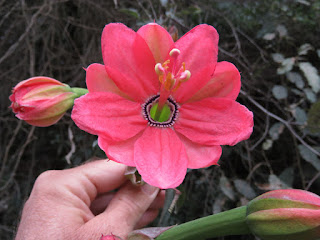


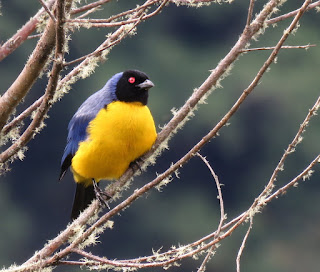
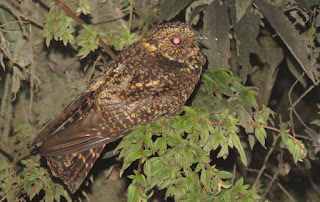




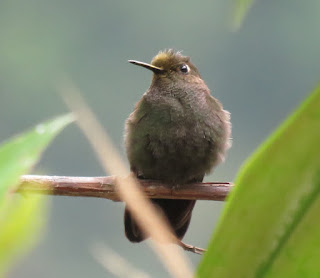






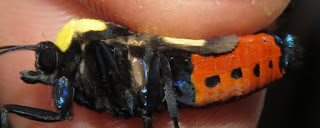






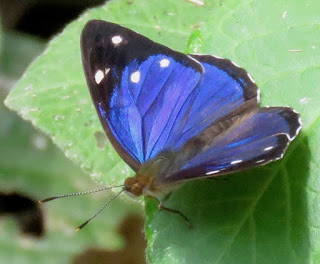


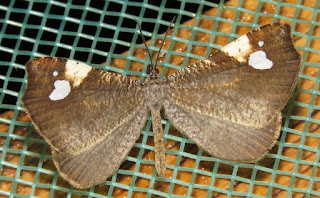


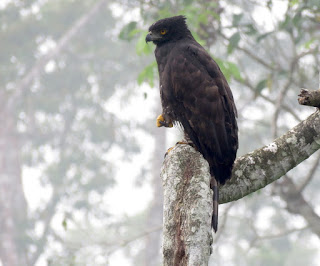





No comments:
Post a Comment